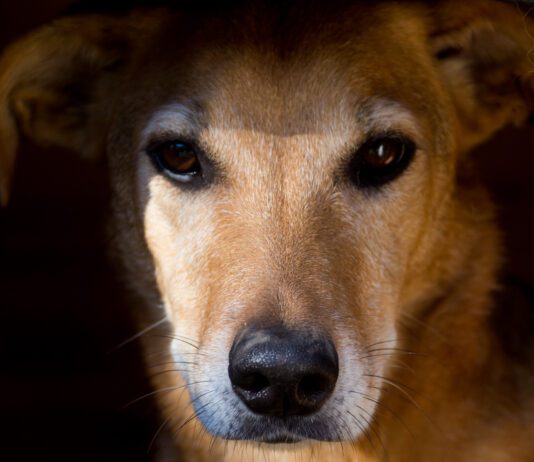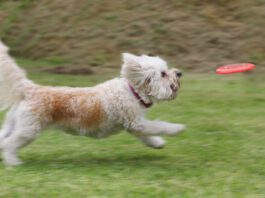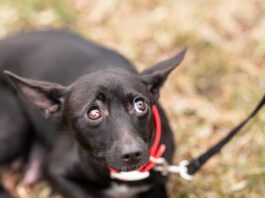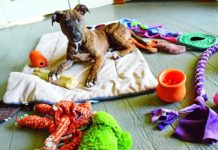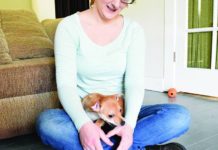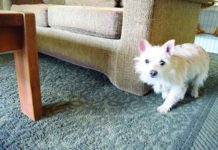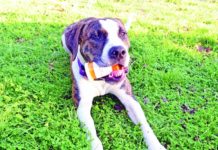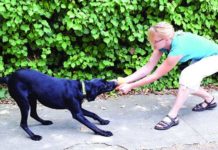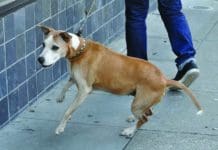4 Puppy Biting Survival Strategies
Puppies! Who doesn't love 'em? They're cute, cuddly, and silly. They look like little angels when they sleep, which is often. When they're awake,...
Teaching Your Puppy Bite Inhibition
Some puppies have a naturally soft bite; some joyfully shred flesh without a hint of malice as they engage in normal interactions with the...
Ways to Stop a Dog from Whining
Dogs whine for a variety of reasons. Understanding your dog's motivation for whining will lead you to the appropriate modification approach. Misinterpreting the whine, or simply chastising or otherwise punishing your dog for whining, can exacerbate the behavior and even give rise to other more serious behavioral issues. Consider these possible causes.
Stop Urine Marking in the House
This dog had developed a strong habit of urine marking in the house. His owner is managing the situation by making the dog wear a belly band (with a disposable sanitary pad inside), while also encouraging him to use puppy pads" to relieve himself if need be. A security camera confirmed that he's using the pads!üKeep a close watch on your dog
Why Dogs Bark and How to Stop Them
Barking is a natural, normal canine behavior. If you have a dog, you need to understand and accept that sometimes dogs bark! Dogs bark for a variety of reasons. How you work to manage and modify your dog's barking will depend, at least in part, on what motivates him to bark.Step one of any good dog barking modification program is minimizing your dog's need and opportunity to bark. Exercise, an important element of many good behavior modification programs, is useful here as well. A tired dog has less energy, hence less need to bark, and a well-exercised dog tends to be emotionally healthier as well.
How to Teach Your Dog to Trade
Training a dog to "drop it!" is extremely useful, but what about when you're dealing with a resource-guarding dog, or a dog who insists...
Rules for Playing Tug
A couple of decades ago, when positive reinforcement-based training was in its infancy, we were quite sensitive to criticism from the dog training community about this new permissive" style of dog training. When we began encouraging people to play tug with their dogs
Dog Growling is a Good Thing!
Finishing up my morning chores, I am sweeping the barn aisle when I hear ferocious growling erupt in the feed room. Do I drop...
Separation Anxiety in Dogs: Symptoms and How to Modify the Behavior
not "acting out."üSome dogs may be merely vigilant about the arrivals and departures of their humans until a traumatic event (such as a household move or the loss of a family member) triggers a major shift into dramatically anxious behavior."
8 Steps to a Behaviorally Healthy Dog
You can start the process of socializing and training at any stage of a dog's life! Making positive associations for your dog is faster and easier for youngsters than adults, but it's always worth trying to teach new ways of thinking that will improve your dog's quality of life and overall happiness.
Why (and How) Dogs Escape Fences
The risks for a free-roaming dog are legion, including, but not limited to: getting hit by a car, shot by an irate neighbor or a police officer protecting public safety, attacking or being attacked by other animals, being picked up by animal control, or simply vanishing, never to be seen again. Yet some dogs seem hell-bent on escaping doing everything they can think of to get over, under, around, or through their humans' containment strategies. What do you do when you have a dog who is dedicated to escaping his yard?
Why We Don’t Recommend Electric Fences (Shock Collars)
this makes many of them associate whatever they saw that drew them toward the boundary other dogs


